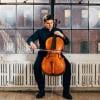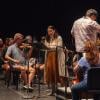
The pair of orchestral concerts on Saturday and Sunday that concluded the 2024 Cabrillo Festival of Contemporary Music brought a star lineup of soloists together in Santa Cruz, including cellist Gabriel Cabezas, trumpeter Michael Sachs, and violinist Philippe Quint. All of the compositions addressed the theme of this year’s festival, “Music as Movement,” but in highly divergent ways. The movement was readily evident across cultures, space, and even history.
First up was Cabezas, featured in a journey across landscapes and geologic epochs as represented in Gabriella Smith’s Lost Coast, which premiered in Los Angeles in 2023. The piece is inspired by the Berkeley-born composer’s five-day trek in California’s remote north and is organized as a series of cadenzas and obbligato lines among musical vistas in which swirling, surging strings wash into steep cliffs of strong brass chords.
Cabezas’s amplified solo cello enhanced Smith’s scene-setting and freely traversed a variety of emotions utilizing the virtuosic range of the instrument. His spectacular performance brought out the full spectrum of anxieties inherent in the work. Indeed, recounting that trek, Smith says she awoke one morning to find her tent encircled by bear paw prints. The bear circling Lost Coast is climate change, and Smith and Cabezas have evoked fear, awe, and apprehension while still rescuing hope.

Sachs had the difficult job of following this vast performance. Fortunately, Wynton Marsalis’s 2023 Concerto for Trumpet begins with an elephant call, and Sachs did it with natural exuberance. Aside from such moments of musical onomatopoeia, the concerto is a historical travelogue (contrasting with the emotional force of Lost Coast).
Marsalis’s concerto is a parade of styles, and Sachs, the piece’s dedicatee, was here giving the West Coast premiere. He showed his stylistic range and facility as well as his and Marsalis’s deep devotion to the heritage of the trumpet. Sachs led a six-movement journey through military marches, big-band music, klezmer, and more. He mingled sensitively with the orchestra, and his sound brightened and warmed up most notably as the music turned from Haydn- and Debussy-inspired movements to infectious fusions of jazz and mariachi.
The second half of Saturday’s concert featured the world premiere of Bora Yoon’s Parhelion — the first work from the festival’s Creative Lab initiative. Yoon’s piece evokes the atmospherics of its title — the iridescence of sun dogs in the sky. As a multimedia work, Parhelion decenters the orchestra, scattering the musicians around the stage. In performance, Yoon employed her multiple distinctive talents, singing, reciting poetry by Rainer Maria Rilke, flipping through a Bible, and more. Indeed, she flipped the script on “Music as Movement”; the scraping of pages and shifting of players were among many motions in the performance, which also included NASA video of solar activity, projected animations of abstractions, and spotlights sweeping around the hall.

Eventually points of light held by ushers and audience members scattered in the dry-ice-fogged dark. Space and light prevailed but were integrated with sound in a mesmerizing experience. Electrostatics (a solar-atmosphere effect), found audio from a local weather forecast, live-performed walkie-talkie feedback (that sounded somehow like infant cries), and of course, Yoon’s own incantations were the dominant sonic material.
Parhelion expands the notion of orchestral composition by harkening back to spatial sacred works of the Renaissance by Giovanni Gabrieli and Claudio Monteverdi. The piece is specifically set for the rounded shape of the Civic Auditorium and also evokes the seaside location of Santa Cruz itself. We can hope that Yoon gets creative license to do more of this work.
Sunday’s concert also moved adeptly across cultures and historical styles. The opening work, Clarice Assad’s Baião ’N’ Blues (2023), was prefaced by a dance demonstration of Brazilian baião. Then Assad’s music transformed the syncopations with a vivacious symphonic palette. Harmonies infused the dance rhythms with the sound of American blues. The fusion of Assad’s composition underscores the adaptability of the orchestral medium.
The following work, Errollyn Wallen’s Violin Concerto (2024), drew on the considerable strengths of soloist Quint. The concerto opens in shimmering suspense, and then soloist and orchestra creep in with darkly foreboding tones and chimes. Ultimately, Quint leapt about the strings acrobatically, maintaining his glowing tone all the while. This is a star vehicle, but the orchestra is marshalled cleverly and assertively, too.

Two works closed the festival by honoring tradition. Pierre Jalbert’s Passage (2018) is a scrapbook of the rhythmic relentlessness and paradoxically balletic grace of Beethoven’s Fourth Symphony. Jalbert weaves quotations into his contemporary idiom. Spoiler alert: In transforming Beethoven, Jalbert manages to push the quotes over the precipice of Igor Stravinsky’s The Rite of Spring. Moody, concentrated, and crafty to the end, Passage ends in a blaze of orchestral virtuosity.
The fun continued with Juan Pablo Contreras’s Mariachitlán (2016), in which rhythm and bright color combine for a cinematic street scene. It was tempting to want to join in and dance on behalf of orchestras everywhere.
All of the weekend’s works — no matter how specific to the soloists or venue — have the potential to thrive in future performances. The Cabrillo Festival again lived up to its special mission on behalf of contemporary orchestral music, not least because Music Director Cristian Măcelaru and the Cabrillo Festival Orchestra served this diverse, unfamiliar music with astonishing clarity, color, and expressive warmth. May this music continue to get such royal treatment and move far and wide.




